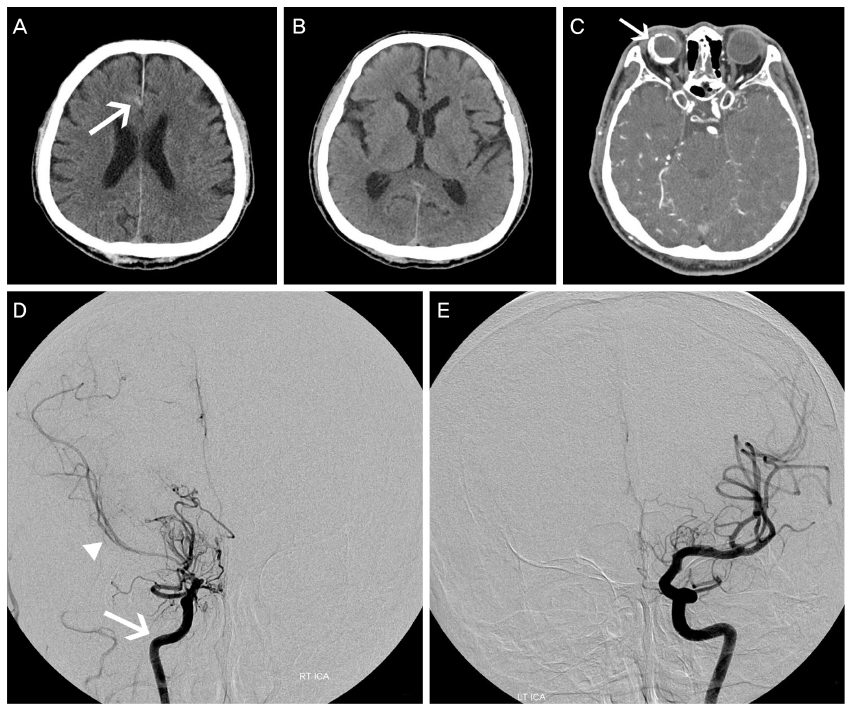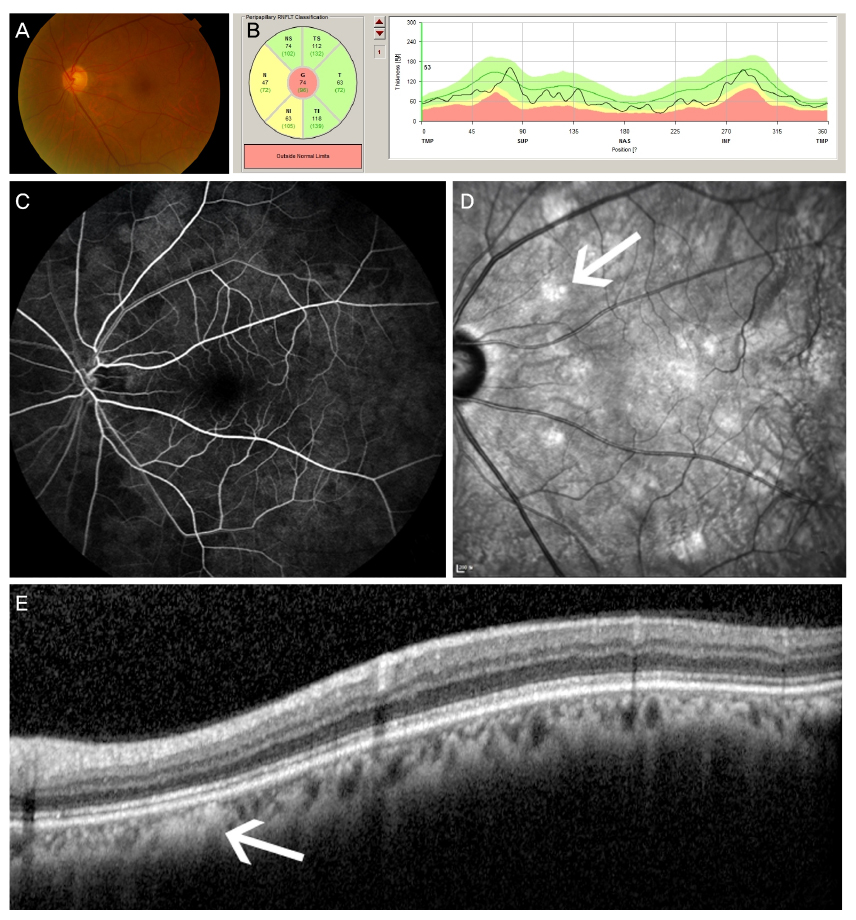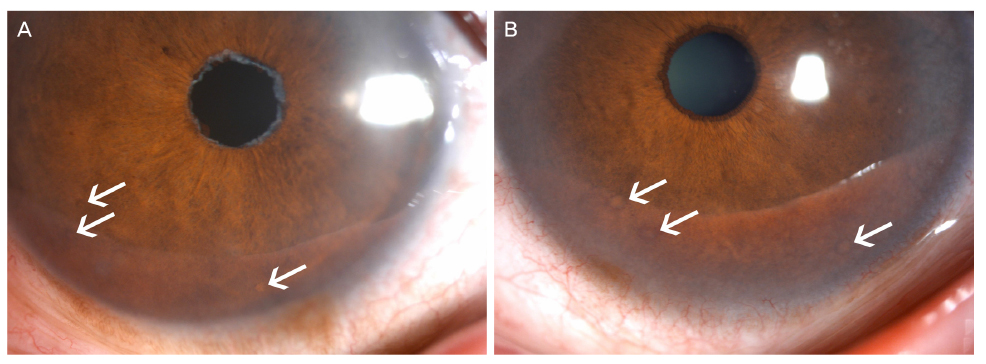J Korean Ophthalmol Soc.
2018 Jan;59(1):98-103. 10.3341/jkos.2018.59.1.98.
A Case of Moyamoya Syndrome Diagnosed by Ophthalmic Examination in a Patient with Moyamoya Disease
- Affiliations
-
- 1Department of Ophthalmology, Sanggye Paik Hospital, Inje University College of Medicine, Seoul, Korea. brio17@naver.com
- KMID: 2401685
- DOI: http://doi.org/10.3341/jkos.2018.59.1.98
Abstract
- PURPOSE
To report a case of moyamoya syndrome after an additional diagnosis of neurofibromatosis type 1 (NF 1) using an ophthalmic examination in a middle-aged patient with moyamoya disease.
CASE SUMMARY
A 60-year-old male with no specific past medical history except moyamoya disease visited our hospital for an ophthalmic examination. Two years prior, he had been diagnosed with moyamoya disease by brain imaging performed after a head trauma. At the first visit, his best corrected visual acuity was no light perception in the right eye (OD) and 20/25 in the left eye (OS). The intraocular pressure was 8 mmHg (OD) and 10 mmHg (OS). On fundus examination, the right eye showed a dense opacity of an ocular media and the left eye showed no abnormality except an increased cup-to-disc ratio. However, infrared imaging showed multiple whitish lesions in the left eye. Fluorescein angiography showed a patchy choroidal filling delay. During the follow-up, slit-lamp microscopy revealed Lisch nodules and multiple café au lait spots and neurofibromas were found in the skin which led to the diagnosis of NF 1.
CONCLUSIONS
When examining patients with moyamoya disease, ophthalmologists should check not only ocular comorbidity associated with moyamoya disease but also ocular comorbidity with other systemic diseases that can accompany moyamoya disease. NF 1 is the most common systemic disease associated with moyamoya syndrome. In this case, appropriate follow-up was essential to monitor the development of ocular or systemic vasculopathies and their complications.
MeSH Terms
Figure
Reference
-
1. Scott RM, Smith ER. Moyamoya disease and moyamoya syndrome. N Engl J Med. 2009; 360:1226–1237.
Article2. Williams M, Adas A, Sharma N, Gibson M. Moyamoya disease presenting to the ophthalmology clinic. Can J Ophthalmol. 2006; 41:633–634.
Article3. Phi JH, Wang KC, Lee JY, Kim SK. Moyamoya syndrome: a window of moyamoya disease. J Korean Neurosurg Soc. 2015; 57:408–414.
Article4. Huson S, Jones D, Beck L. Ophthalmic manifestations of neurofibromatosis. Br J Ophthalmol. 1987; 71:235–238.
Article5. Bang J, Yang HS, Ahn JH, et al. Ophthalmic manifestations in patients with neurofibromatosis. J Korean Ophthalmol Soc. 2008; 49:1829–1838.
Article6. Takeuchi K, Shimizu K. Hypoplasia of the bilateral internal carotid arteries. Brain Nerve. 1957; 9:37–43.7. Suzuki J, Takaku A. Cerebrovascular “moyamoya” disease. Disease showing abnormal net-like vessels in base of brain. Arch Neurol. 1969; 20:288–299.8. Witmer MT, Levy R, Yohay K, Kiss S. Ophthalmic artery ischemic syndrome associated with neurofibromatosis and moyamoya syndrome. JAMA Ophthalmol. 2013; 131:538–539.
Article9. Ferner RE. Neurofibromatosis 1 and neurofibromatosis 2: a twenty first century perspective. Lancet Neurol. 2007; 6:340–351.
Article10. Lee YH, Kim KN, Shin KS, Kim JY. Hemi-central retinal vein occlusion in a patient with neurofibromatosis 1. J Korean Ophthalmol Soc. 2010; 51:150–154.
Article11. Salyer WR, Salyer DC. The vascular lesions of neurofibromatosis. Angiology. 1974; 25:510–519.
Article12. Hamilton SJ, Freidman JM. Insights into the pathogenesis of neurofibromatosis 1 vasculopathy. Clin Genet. 2000; 58:341–344.
Article13. Viola F, Villani E, Natacci F, et al. Choroidal abnormalities detected by near-infrared reflectance imaging as a new diagnostic criterion for neurofibromatosis 1. Ophthalmology. 2012; 119:369–375.
Article14. Abdolrahimzadeh S, Felli L, Plateroti R, et al. Morphologic and vasculature features of the choroid and associated choroid-retinal thickness alterations in neurofibromatosis type 1. Br J Ophthalmol. 2015; 99:789–793.
Article15. Koss M, Scott RM, Irons MB, et al. Moyamoya syndrome associated with neurofibromatosis Type 1: perioperative and long-term outcome after surgical revascularization. J Neurosurg Pediatr. 2013; 11:417–425.
Article16. Monroe CL, Dahiya S, Gutmann DH. Dissecting clinical heterogeneity in neurofibromatosis type 1. Annu Rev Pathol. 2017; 12:53–74.
Article
- Full Text Links
- Actions
-
Cited
- CITED
-
- Close
- Share
- Similar articles
-
- Moyamoya Syndrome: A Window of Moyamoya Disease
- Neuroimaging Diagnosis and Treatment of Moyamoya Disease
- A Case of Ophthalmic Artery Occlusion in Moyamoya Disease
- Moyamoya Syndrome Associated With Hashimoto's Thyroiditis
- Allergic Reaction Induced Brainstem Stroke in a Patient With Moyamoya Disease: A Case Report




